Wojtek (bear)
Wojtek (1942–1963; Polish pronunciation: [ˈvɔjtɛk]; in English, sometimes spelled Voytek and pronounced as such) was a Syrian brown bear (Ursus arctos syriacus) bought, as a young cub, at a railway station in Hamadan, Iran, by Polish II Corps soldiers who had been evacuated from the Soviet Union. In order to provide for his rations and transportation, he was eventually enlisted officially as a soldier with the rank of private, and was subsequently promoted to corporal.[1]
Corporal Wojtek the Soldier Bear | |
|---|---|
 Polish soldier with Wojtek in 1942 | |
| Born | 1942 Hamadan, Iran |
| Died | 2 December 1963 (aged 21) Edinburgh Zoo, Scotland |
| Allegiance | Poland |
| Service/ | |
| Years of service | 1943–45 |
| Rank | |
| Unit | 3522, 22nd Artillery Supply Company, II Corps (Poland) |
| Battles/wars | World War II |
| Memorials | Wojtek Memorial Trust |
| Website | thesoldierbear |
He accompanied the bulk of the II Corps to Italy, serving with the 22nd Artillery Supply Company. During the Battle of Monte Cassino, in Italy in 1944, Wojtek helped move crates of ammunition and became a celebrity with visiting Allied generals and statesmen. After the war, mustered out of the Polish Army, he was billeted and lived out the rest of his life at the Edinburgh Zoo in Scotland.
Life
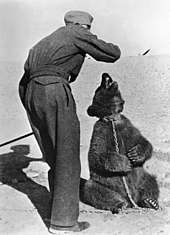
In the spring of 1942 the newly formed Anders' Army left the Soviet Union for Iran, accompanied by thousands of Polish civilians who had been deported to the Soviet Union following the 1939 Soviet invasion of eastern Poland. At a railroad station in Hamadan, Iran, on 8 April 1942, Polish soldiers encountered a young Iranian boy who had found a bear cub whose mother had been shot by hunters. One of the civilian refugees in their midst, eighteen-year-old Irena (Inka) Bokiewicz, the great-niece of General Bolesław Wieniawa-Długoszowski, was very taken with the cub. She prompted Lieutenant Anatol Tarnowiecki to buy the young bear, which spent the next three months in a Polish refugee camp established near Tehran, principally under Irena's care.[2] In August, the bear was donated to the 2nd Transport Company, which later became the 22nd Artillery Supply Company, and he was named Wojtek by the soldiers. The name Wojtek is the nickname, diminutive form, or hypocorism of "Wojciech" (Happy Warrior), an old Slavic name still common in Poland.[3]
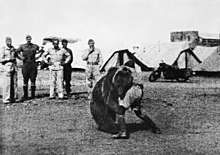
Wojtek initially had problems swallowing and was fed condensed milk from an old vodka bottle. He was subsequently given fruit, marmalade, honey, and syrup, and was often rewarded with beer, which became his favourite drink. He later also enjoyed smoking (or eating) cigarettes, as well as drinking coffee in the mornings. He also would sleep with the other soldiers if they were ever cold in the night.[4][5] He enjoyed wrestling with the soldiers and was taught to salute when greeted. He became an attraction for soldiers and civilians alike, and soon became an unofficial mascot to all the units stationed nearby. With the 22nd Company, he moved to Iraq, and then through Syria, Palestine, and Egypt.[6] Wojtek copied the other soldiers, drinking beer, smoking and even marching alongside them on his hind legs because he saw them do so. Wojtek had his own caregiver, assigned to look after him. The cub grew up while on campaign, and by the time of the Battle of Monte Cassino he weighed 200 pounds (14 st; 91 kg).[7]
Private Wojtek
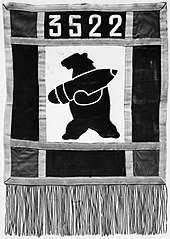
From Egypt, the Polish II Corps was reassigned to fight alongside the British Eighth Army in the Italian campaign. Regulations for the British transport ship, which was to carry them to Italy, forbade mascot and pet animals. To get around this restriction, Wojtek was officially drafted into the Polish Army as a private and listed among the soldiers of the 22nd Artillery Supply Company. Henryk Zacharewicz and Dymitr Szawlugo were assigned as his caretakers.
As an enlisted soldier with his own paybook, rank, and serial number, he lived with the other men in tents or in a special wooden crate, which was transported by truck. During the Battle of Monte Cassino, Wojtek helped his unit to convey ammunition by carrying 100-pound (45 kg) crates of 25-pound artillery shells, never dropping any of them. While this story generated controversy over its accuracy, at least one account exists of a British soldier recalling seeing a bear carrying crates of ammo.[9] The bear mimicked the soldiers: when he saw the men lifting crates, he copied them. Wojtek carried boxes that normally required 4 men, which he would stack onto a truck or other ammunition boxes.[10] This service at Monte Cassino earned him promotion to the rank of corporal. In recognition of Wojtek's popularity, a depiction of a bear carrying an artillery shell was adopted as the official emblem of the 22nd Company.[6][7]
Post war
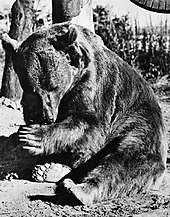
After the end of World War II in 1945, Wojtek was transported to Berwickshire, Scotland, with the rest of the 22nd Company. They were stationed at Winfield Airfield on Sunwick Farm, near the village of Hutton, Scottish Borders. Wojtek soon became popular among local civilians and the press, and the Polish-Scottish Association made him an honorary member.
Following demobilization on 15 November 1947, Wojtek was given to Edinburgh Zoo, where he spent the rest of his life, often visited by journalists and former Polish soldiers, some of whom tossed cigarettes for him to eat, as he did during his time in the army.[11] Media attention contributed to Wojtek's popularity. He was a frequent guest on BBC television's Blue Peter programme for children.[12]
Wojtek died in December 1963, at the age of 21. At the time of his death he weighed nearly 35 stone (490 lb; 220 kg), and was over 6 feet (1.8 m) tall.[6]
Legacy
- The many memorials to the soldier-bear include a plaque in the Imperial War Museum, in London; a sculpture by David Harding in the Sikorski Museum, in London; and a wooden sculpture in Weelsby Woods, Grimsby.[13]
- In 2013, the Kraków city council decided to erect a statue of Wojtek in the city's Jordan Park. It was unveiled on 18 May 2014, the 70th anniversary of the Battle of Monte Cassino.[14][15]
- In 2013, the City of Edinburgh Council approved the erection of a bronze statue of Wojtek, by Alan Beattie Herriot, to stand in the city's West Princes Street Gardens.[16] Unveiled in 2015, it presents Wojtek and a fellow Polish Army soldier walking together. A 1.5-metre (five-foot-long) relief documents Wojtek's journey from Egypt to Scotland with the Polish Army.[17][18]
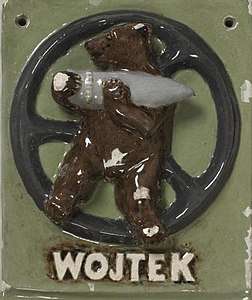 Plaque in the Imperial War Museum
Plaque in the Imperial War Museum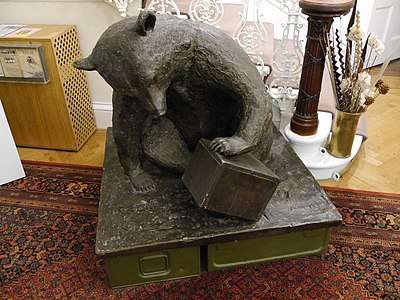 Sculpture by David Harding in the Sikorski Museum
Sculpture by David Harding in the Sikorski Museum- Monument to Wojtek in Jordan Park, Kraków
_statue_in_Princes_Street_Gardens.jpg) Monument to Wojtek in West Princes Street Gardens, Edinburgh
Monument to Wojtek in West Princes Street Gardens, Edinburgh
See also
References
- "Pomnik legendarnego niedźwiedzia Wojtka stanął w Krakowie" [Statue of the legendary bear Wojtek unveiled in Krakow]. Telewizja Polska (in Polish). 19 May 2014. Retrieved 24 December 2015.
- "O niedźwiedziu, który był polskim żołnierzem" [The bear who was a Polish soldier]. Polonia Włoska — Biuletyn Informacyjny (in Polish). Vol. 18 no. 1–2. 17 July 2013. p. 24. Retrieved 24 December 2015.
- "Meaning, Origin and History of the Name Wojciech". Behind the Name. 2014. Retrieved 15 August 2014.
- "Wojtek wraca" [Wojtek returns]. Polityka (in Polish). 2 February 2008. p. 11.
- "Smarter than the average bear .. by far". Edinburgh Evening News. 28 March 2007. Retrieved 15 August 2014.
- "Private Wojtek, the 35-stone bear who battled Nazis to be remembered with statue". Mail Online. 14 October 2010. Retrieved 15 August 2014.
- "The Soldier Bear Who Went to War", BBC Outlook
- Sansone, Adele (9 July 2013). "'Private Wojtek' alias Voytek, ein Bär im Dienste der Armee" ['Private Wojtek' alias Voytek, a bear in the service of the Army]. Suite101 (in German). Retrieved 15 August 2014.
- https://forum.axishistory.com/viewtopic.php?t=191546
- Orr, Aileen (1 November 2010). Wojtek the Bear – Polish War Hero. Birlinn Publishers. p. 45. ISBN 978-1-84158-845-2.
- Hale, Beth (25 January 2008). "The hero bear who went to war (and loved a smoke and a beer)". Mail Online. Retrieved 15 August 2014.
- "The story of Wojtek – the soldier bear who was promoted to Corporal". iNews. 29 December 2017. Retrieved 22 June 2018.
- "Polish soldiers meet Wojtek the bear ‒ Grimsby's tribute to Second World War heroes". Grimsby Telegraph. 29 October 2011. Retrieved 15 August 2014.
- "Krakow votes for WWII soldier bear statue". Polskie Radio. 26 April 2013. Retrieved 15 August 2014.
- Polski, Pilnuj (13 May 2014). "Niedźwiedź Wojtek będzie miał swój pomnik w krakowskim Parku Jordana" [Wojtek the Bear will have his monument in Krakow's Jordana Park] (in Polish). Wpolityce.pl. Retrieved 15 August 2014.
- "The Statue". Wojtek Memorial Trust. Retrieved 31 March 2016.
- McCann, David (29 May 2013). "Prince Street Gardens statue of Polish army bear". The Scotsman. Retrieved 15 August 2014.
- "Niedźwiedź Wojtek w Princes Street Gardens" [Wojtek the Bear in Princes Street Gardens] (in Polish). Emito.net. 30 September 2013. Retrieved 15 August 2014.
Further reading
- Anders, Wladyslaw (1949). An Army in Exile, the Story of the Second Polish Corps. London: Macmillan.
- Kleczkowski, Stefan (1945). Poland's first 100,000: Story of the Rebirth of the Polish Army, Navy and Air Force After the September Campaign. London & New York: Hutchinson.
- Morgan, Geoffrey; Lasocki, Wiesław A. (1970). Soldier Bear. London: Collins. ISBN 0-00-211793-2.
- Dumon Tak, Bibi (2011). Soldier Bear. Grand Rapids, Michigan: Wm. B. Eerdmans Publishing Co. ISBN 978-0-8028-5375-2.
- Orr, Aileen (2012). Wojtek the Bear: Polish War Hero. Edinburgh: Birlinn Publishers. ISBN 978-1-84341-057-7.
- Ivell, Krystyna; Baczor, Vic (2013). Wojtek Album. London: Self-published. ISBN 978-0-9926327-0-0.
External links
| Wikimedia Commons has media related to Wojtek (soldier bear). |
- "Honour sought for 'Soldier Bear'". BBC News. London: BBC. 25 January 2008.
- WOJTEK: The unusual Polish soldier that drank beer and went to war.
- Polec, Patryk (2008). "Wojtek The Soldier Bear – In the Ranks of Victors". wojtek-soldierbear.weebly.com.
- "Wojtek the Bear". wojtekthebear.com. 2014.
- "Wojtek – the Soldier Bear – Niedźwiedź Żołnierz". Facebook. 2014. A group supporting and publicizing historical projects around the world.
- "Kresy-Siberia Virtual Museum". kresy-siberia.org. 2014. Site devoted to preserving the history into which Wojtek fits.
- Burman, J. (25 June 2011). "Polish veteran had special comrade". The Hamilton Spectator.
- Vennard, Martin (16 November 2011). "Story of Poland's 'soldier bear' Wojtek turned into film". BBC World Service.
- "Article in Polish with lots of links about Wojtek". Archived from the original on 6 November 2013. Retrieved 3 December 2013.
- One Photo One Story: Wojtek the Soldier Bear, Culture.pl.